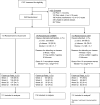Effect of Mindfulness-Based Stress Reduction vs Cognitive Behavioral Therapy or Usual Care on Back Pain and Functional Limitations in Adults With Chronic Low Back Pain: A Randomized Clinical Trial
- PMID: 27002445
- PMCID: PMC4914381
- DOI: 10.1001/jama.2016.2323
Effect of Mindfulness-Based Stress Reduction vs Cognitive Behavioral Therapy or Usual Care on Back Pain and Functional Limitations in Adults With Chronic Low Back Pain: A Randomized Clinical Trial
Abstract
Importance: Mindfulness-based stress reduction (MBSR) has not been rigorously evaluated for young and middle-aged adults with chronic low back pain.
Objective: To evaluate the effectiveness for chronic low back pain of MBSR vs cognitive behavioral therapy (CBT) or usual care.
Design, setting, and participants: Randomized, interviewer-blind, clinical trial in an integrated health care system in Washington State of 342 adults aged 20 to 70 years with chronic low back pain enrolled between September 2012 and April 2014 and randomly assigned to receive MBSR (n = 116), CBT (n = 113), or usual care (n = 113).
Interventions: CBT (training to change pain-related thoughts and behaviors) and MBSR (training in mindfulness meditation and yoga) were delivered in 8 weekly 2-hour groups. Usual care included whatever care participants received.
Main outcomes and measures: Coprimary outcomes were the percentages of participants with clinically meaningful (≥30%) improvement from baseline in functional limitations (modified Roland Disability Questionnaire [RDQ]; range, 0-23) and in self-reported back pain bothersomeness (scale, 0-10) at 26 weeks. Outcomes were also assessed at 4, 8, and 52 weeks.
Results: There were 342 randomized participants, the mean (SD) [range] age was 49.3 (12.3) [20-70] years, 224 (65.7%) were women, mean duration of back pain was 7.3 years (range, 3 months-50 years), 123 (53.7%) attended 6 or more of the 8 sessions, 294 (86.0%) completed the study at 26 weeks, and 290 (84.8%) completed the study at 52 weeks. In intent-to-treat analyses at 26 weeks, the percentage of participants with clinically meaningful improvement on the RDQ was higher for those who received MBSR (60.5%) and CBT (57.7%) than for usual care (44.1%) (overall P = .04; relative risk [RR] for MBSR vs usual care, 1.37 [95% CI, 1.06-1.77]; RR for MBSR vs CBT, 0.95 [95% CI, 0.77-1.18]; and RR for CBT vs usual care, 1.31 [95% CI, 1.01-1.69]). The percentage of participants with clinically meaningful improvement in pain bothersomeness at 26 weeks was 43.6% in the MBSR group and 44.9% in the CBT group, vs 26.6% in the usual care group (overall P = .01; RR for MBSR vs usual care, 1.64 [95% CI, 1.15-2.34]; RR for MBSR vs CBT, 1.03 [95% CI, 0.78-1.36]; and RR for CBT vs usual care, 1.69 [95% CI, 1.18-2.41]). Findings for MBSR persisted with little change at 52 weeks for both primary outcomes.
Conclusions and relevance: Among adults with chronic low back pain, treatment with MBSR or CBT, compared with usual care, resulted in greater improvement in back pain and functional limitations at 26 weeks, with no significant differences in outcomes between MBSR and CBT. These findings suggest that MBSR may be an effective treatment option for patients with chronic low back pain.
Trial registration: clinicaltrials.gov Identifier: NCT01467843.
Conflict of interest statement
Conflicts of interest and financial disclosures: All authors report no conflicts of interest or disclosures.
Figures
Comment in
-
Is It Time to Make Mind-Body Approaches Available for Chronic Low Back Pain?JAMA. 2016 Mar 22-29;315(12):1236-7. doi: 10.1001/jama.2016.2437. JAMA. 2016. PMID: 27002443 No abstract available.
-
Mindfulness-Based Stress Reduction Improves Outcomes in Adults With Chronic Low Back Pain.J Am Osteopath Assoc. 2016 Jul 1;116(7):485-6. doi: 10.7556/jaoa.2016.094. J Am Osteopath Assoc. 2016. PMID: 27367954 No abstract available.
-
Osteopathic Manipulative Therapy for Preterm Infants, Acupuncture for Menopausal Symptoms, Mindfulness-Based Stress Reduction for Chronic Low Back Pain, Chocolate for Ischemic Heart Disease, Berberine for Irritable Bowel Syndrome.Explore (NY). 2016 Sep-Oct;12(5):388-92. doi: 10.1016/j.explore.2016.06.015. Epub 2016 Jun 23. Explore (NY). 2016. PMID: 27473312 No abstract available.
-
Mindfulness-Based Stress Reduction vs Cognitive Behavioral Therapy for Chronic Low Back Pain.JAMA. 2016 Aug 9;316(6):663. doi: 10.1001/jama.2016.7948. JAMA. 2016. PMID: 27532923 No abstract available.
-
Mindfulness-Based Stress Reduction vs Cognitive Behavioral Therapy for Chronic Low Back Pain--Reply.JAMA. 2016 Aug 9;316(6):663-4. doi: 10.1001/jama.2016.7951. JAMA. 2016. PMID: 27532924 No abstract available.
References
-
- Martin BI, Deyo RA, Mirza SK, et al. Expenditures and health status among adults with back and neck problems. JAMA. 2008;299:656–664. A published erratum appears in JAMA 2008;299:2630. - PubMed
-
- Chou R, Qaseem A, Snow V, et al. Clinical Efficacy Assessment Subcommittee of the American College of Physicians; American College of Physicians; American Pain Society Low Back Pain Guidelines Panel Diagnosis and treatment of low back pain: a joint clinical practice guideline from the American College of Physicians and the American Pain Society. Ann Intern Med. 2007;147:478–491. - PubMed
Publication types
MeSH terms
Associated data
Grants and funding
LinkOut - more resources
Full Text Sources
Other Literature Sources
Medical
Miscellaneous


